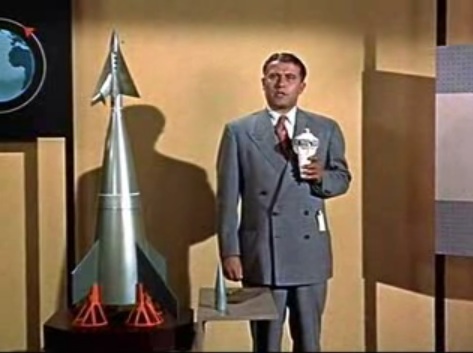I will never see Wernher Von Braun without thinking about Tom Lehrer, followed immediately by Operation Paperclip. It must have been awkward for Willy Ley, another scientist appearing in this, who escaped from Germany in 1935 with only his favourite books and a few changes of clothing, given that the other two working with Disney here were Von Braun and Heinz Haber, both of whom were brought to the US under Operation Paperclip. Now, Ley was a writer, but he was a writer who worked very hard to popularize science and the idea of rockets. At the same time, Von Braun was building the rockets that would fall on the UK. You know, different career paths.
This is another example of Walt’s famous futurism. Actually, after introducing the thing, he gets out of the way and Ward Kimball takes over. He gives a brief rundown of the history of the rocket, both fact and fiction. Willy Ley, described as a “rocket historian,” gives a rundown of how rockets work, using a real engine from a V2 as a demonstration model. They then delve into speculation, with Ley discussing the possibility of a satellite in polar orbit gathering information about the next step. Heinz Haber is on next, referred to as an expert on space medicine; let’s not talk about some of his known experiments la la la. Wernher Von Braun shows up to talk about designing rockets, which have nothing in common with ones built by slave labour and sent to attack the UK la la la.
The special brushes over such minor details as the Nazis’ suppression of Die Frau im Mond, which Ley had worked on, because of its incredibly realistic rocket design. “Soon after” events of the 1920s and ‘30s is also doing a lot of work when discussing German rocketry. It is actually possible to spot Operation Paperclip between the lines, if you know what you’re looking for—not just Von Braun and Haber, but in the history section. Mostly the section is a lot of rockets launching—well, you don’t want to show the more disastrous bits of the US rocket program at the time, so V2 and V2-descended rockets make for a better film.
This is four years before, at the suggestion of Haber and his brother—and fellow Paperclip alumnus—Fritz, who doesn’t get his own Wikipedia page, NASA would start instituting parabolic flights to simulate weightlessness for astronaut training. However, Haber gives a lengthy talk about the effects of weightlessness on humans. I don’t know how much of what he describes here would eventually be used; I’m quite certain astronauts don’t play 3D pool, for starters. But while Haber was a war criminal who tested effects of low pressure on Dachau prisoners, he was also important to how the US cares for its astronauts.
The rocket Von Braun described would never be built the way he demonstrates it here. The physics stays the same, but the fourth stage would later be determined to be impractical. It’s interesting that he suggests a first flight that would include multiple people at once. It would also be deemed to be considerably more practical to launch from Florida—as in, the continental US—rather than islands in the Pacific. Easier to transport who and what you need. Some of these ideas would be realized; most would not.
At Kimball’s suggestion, the animation on the show was considerably simplified from Disney’s normal style. If anything, it more resembles a Fleischer Superman cartoon than a Silly Symphony. Only the parts that move on the humans are fully animated, and if there’s no reason for the human to move, they don’t. Oh, it’s still clear that the multiplanar cameras have been used on some shots, but others are static, merely changes in light on a form or one aspect of an object tilting or the camera’s simply panning down a larger illustration while a few pieces move. It’s quite effective, as it lets you get into the feeling of being there.
This isn’t what spaceflight would eventually look like, but for ‘50s audiences, it was a plausible glimpse of the relatively near future. Walt referred to the whole thing as “science factual,” a way to view science in an entertaining fashion. Honestly it wasn’t a bad idea. There are things in here that are still factual and fascinating. It would’ve been nice if Walt had done more along these lines, not just the futurism stuff. If Walt taught Boomers more about science and history and so forth, we might be in a better place today. Just, you know, maybe he should’ve avoided the war criminals.
Pay me for providing entertainment and education by supporting my Patreon or Ko-fi!

